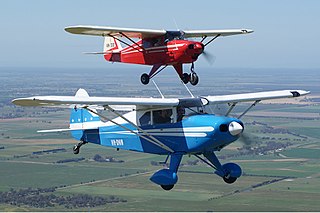
The PA-20 Pacer and PA-22 Tri-Pacer, Caribbean, and Colt are an American family of light strut-braced high-wing monoplane aircraft built by Piper Aircraft from 1949 to 1964.

The Piper PA-18 Super Cub is a two-seat, single-engine monoplane. Introduced in 1949 by Piper Aircraft, it was developed from the PA-11 Cub Special, and traces its lineage back through the J-3 Cub to the Taylor E-2 Cub of the 1930s. In close to 40 years of production, over 10,000 were built. Super Cubs are commonly found in roles such as bush flying, banner towing and glider towing.

The Beechcraft 60 Duke is an American-built twin-engine fixed-wing aircraft designed and produced by Beechcraft. The aircraft has retractable tricycle landing gear and a pressurized cabin. The two piston engines are turbocharged and the turbochargers also pressurize the cabin with bleed air.

The Cessna 441 Conquest II is the first turboprop powered aircraft designed by Cessna, and was meant to fill the gap between their jets and piston-engined aircraft. It was developed in November 1974, with the first aircraft delivered in September 1977. It is a pressurized, 8–9 passenger turbine development of the Cessna 404 Titan.

The Diamond DA40 Diamond Star is an Austrian four-seat, single-engine, light aircraft constructed from composite materials. Built in both Austria and Canada, it was developed as a four-seat version of the earlier DA20 by Diamond Aircraft Industries.
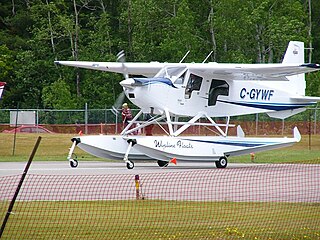
The Found FBA-2 is a 1960s Canadian four/five-seat cabin monoplane that was produced by Found Aircraft.

The Maule M-7 is a family of single-engine light aircraft that has been manufactured in the United States since the mid-1980s.

The American Legend AL3C-100 and American Legend AL11C-100 are new design American light-sport aircraft inspired by the Piper J-3 Cub and Super Cub.
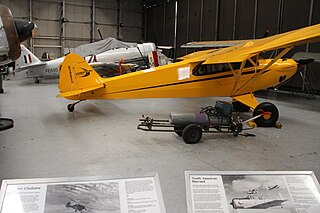
The Cub Crafters CC11-100 Sport Cub S2 is a high-wing, tandem-seat, conventional landing gear–equipped, tube-and-fabric light-sport aircraft built by Cub Crafters. The aircraft certified to ATSM standards for the FAA's Light Sport Category and is in production as of 2010. The S2 was introduced in 2007 as an improvement to the Sport Cub of 2005.

The Glasair Sportsman 2+2 is a single-engine, high wing, strut-braced, four seat kit aircraft, developed by the Glasair Aviation company.
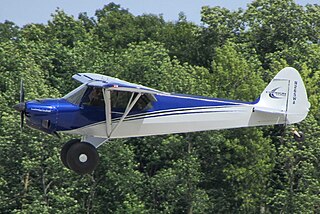
The CubCrafters CC11-160 Carbon Cub SS is an ASTM certified light-sport aircraft based on the Piper J-3 Cub manufactured by Cub Crafters. It is modernized, with light-weight carbon fiber components and a 180 hp (130 kW) engine.

The Pipistrel Alpha Trainer is a Slovenian two-seat, single-engine light-sport aircraft intended specifically for flight training, designed and produced by Pipistrel in Gorizia, Italy.

The Van's Aircraft RV-14 is an American aerobatic kit aircraft designed by Richard VanGrunsven and produced by Van's Aircraft. It was introduced at AirVenture in July 2012. The aircraft is supplied as a kit for amateur construction.

The CubCrafters Carbon Cub EX is an American amateur-built aircraft, designed and produced by Cub Crafters of Yakima, Washington. The aircraft is supplied as a kit for amateur construction.
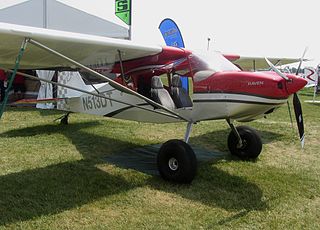
The Rans S-20 Raven is an American homebuilt aircraft that was designed by Randy Schlitter and is produced by Rans Designs of Hays, Kansas, introduced at AirVenture in August 2013. The aircraft is supplied as a kit for amateur construction and it is anticipated that it will later be offered as a complete ready-to-fly-aircraft in the light-sport aircraft category.

The Rans S-21 Outbound is an American STOL homebuilt aircraft that was designed by Randy Schlitter and is produced by Rans Designs of Hays, Kansas. It was introduced at AirVenture in 2016. The aircraft is supplied as a quick-build kit for amateur construction or ready-to-fly.

The CubCrafters CC18-180 Top Cub is an American light aircraft designed and produced by CubCrafters of Yakima, Washington, introduced in 2004. The aircraft is type certified and supplied complete and ready-to-fly.

The Vulcanair V1.0 is an Italian light aircraft, designed and produced by Vulcanair of Casoria, introduced at the AERO Friedrichshafen show in 2014. The aircraft is type certified by the European Aviation Safety Agency and the US Federal Aviation Administration and is supplied complete and ready-to-fly.

The Murphy Yukon is a Canadian amateur-built aircraft, produced by Murphy Aircraft of Chilliwack, British Columbia, introduced at the AirVenture show in 2007. The aircraft is supplied as a kit for amateur construction.
The Tecnam P-Mentor is an Italian light aircraft, intended for flight training, designed and produced by Tecnam of Casoria. It was introduced in April 2022 and is EASA CS-23 type certified in Europe.



















